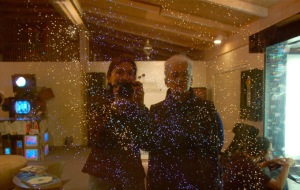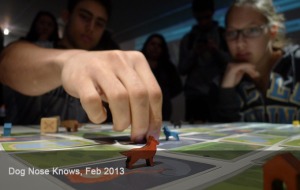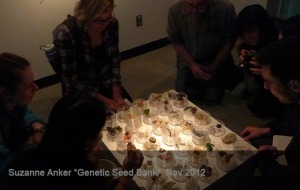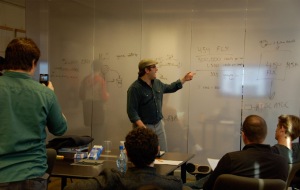The Earth has rotated another seven times, which means it’s time for the next installment of More Than Science. Happy Friday, dear readers!
Today I’d like to share a group I recently found: the Art | Sci Center + Lab at UCLA (University of California, Los Angeles). From their website:
The union of art and science has been gathering steam (sorry for the pun) recently. Often labeled STEAM – for Science, Technology, Engineering, Arts and Math – the marriage of seemingly disparate fields is being touted as the way forward for both inspiring innovative research and getting more kids interested in STEM subjects. [Full disclosure: I am a part of The STEAM Factory at the Ohio State University, so I’ve been thinking about these sorts of things a lot lately.] Interpretations of this marriage vary widely, which I think is a good thing: it can spur educational, research, outreach and artistic endeavors in all directions.
The Art | Science Center + Lab is working in this crossover space in a few different ways. A big focus is developing new ways to educate. On the topic of education, Art | Sci Center + Lab says:
One the center’s big initiatives is the Sci|Art Nanolab, a two-week intensive summer program for high school juniors and seniors. The description on the website says:
Throughout the 2-week intensive program, students will make connections between cutting edge scientific research, popular culture and contemporary arts. Lab visits, workshops, hands-on experiments, and meetings with world renowned scientists will be balanced with visits to museums, daily movie screenings and meetings with famous contemporary artists who collaborate with scientists.

Design project ideas from the 2012 Sci|Art Nanolab program ranged from constructing houses from bamboo to contact lenses that zoom.
Frankly, I would love to attend this program myself! You can check out presentations from last year’s groups here. By encouraging the students to think creatively while learning about different technologies and nano/bio information, the students came up with really interesting design ideas. Projects included: identifying a bacteria that could be used for water bioremediation, designing self-assembling buildings, sustainable bamboo houses for refugee camps, and contact lenses that can zoom in and out.
In his closing presentation, the course coordinator Adam Stieg shows parents of the student participants a video that explains why the course emphasizes learning creatively and innovatively. One of the presentation factoids that really struck me is that the top 10 in-demand jobs in 2010 did not exist in 2004. This effectively means that we are educating students right now for jobs that don’t yet exist, in which they’ll use technologies that haven’t been invented, to solve problems that we’re not yet aware of. Although that sentiment might not be new, exactly, the rapid pace of change – just 6 years, from 2004 to 2010 – blew my mind.
With such a rapidly evolving and uncertain future in front of them, it seems obvious that we should be educating young people not only to possess certain pieces of knowledge or discrete skills, but to be able to think in a flexible way that allows them to adapt – acquiring new skills as needed, pushing themselves to be competitive in an overburdened job market, giving them the confidence and capability to create opportunities for themselves. Yes, I believe in the message of this program.
The group also looks to blend across disciplinary lines among professionals and faculty:
The center presents lectures, mixers, and symposia to bring artists and scientists together in order to mesh these cultures and inspire individuals to think about art and science as already interrelated and relevant to our society.
One avenue for this is called LASER – Leonardo Art Science Evening Rendezvous. These are “monthly evening salons showcasing movers and shakers in art and science”. LASER is a project of Leonardo®/ISAST, started by Piero Scaruffi in San Francisco and spreading to New York, Washington D.C. and L.A. You can watch videos from past UCLA LASER events here, on vimeo. Neat stuff.
The Art | Science Center + Lab is not the only institute to be doing this kind of work, trying to bring some creative and artistic thinking into the pursuit of science. RISD – the Rhode Island School of Design – is a pioneer in the STEM to STEAM initiative (found here and here).
As I mentioned above (alert: shameless plug ahead), I’m part of a group at OSU called The STEAM Factory, which also working on cross-disciplinary research innovation (music + computer science, economics + hydrology, to be continued…) and bringing research to the community via an ongoing presence at a public weekend market.
And I would be completely remiss if I didn’t mention the Media Lab at MIT, which was my first introduction to the brilliance that can arise from opening your mind to non-traditional ways of thinking and doing science. If you ever feel like there is nothing new to invent any more, go spend an hour looking over the Media Lab’s website. It’s just one of the things that make MIT an inspiring place to work.
I’m excited to see this kind of open thinking and doing spread and permeate our ways of learning. It can only lead to more innovative ways of making and refining our societies as we move forward, hopefully leading us to a more sustainable, fulfilling future.
Yours in the pursuit of spaceships,
Bec
Missed what happened in last week’s episode of More Than Science? Catch up here.




Discussion
No comments yet.